EDUCATING THE GLOBAL ARCHITECT
New Policies of Space in Times of Globalisation
18 - 19 April 2009
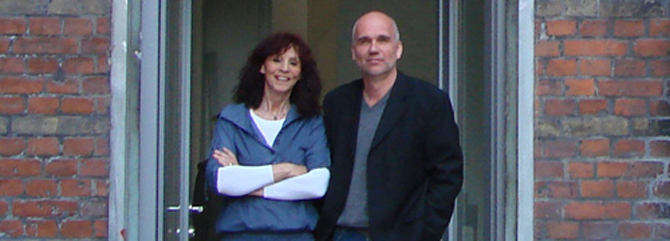
From the Directors
With the inauguration of ANCB, Aedes is very proud to present this unique metropolitan laboratory for the education of ‘global architects’. Offering students and academics the opportunity to engage in an international network of universities, practitioners and specialists, it is our vision to positively contribute to the improvement of our urban environments through an ever-evolving model of trans-disciplinary research.
For the inaugural symposium, we were honoured to host 17 architecture schools from all over the world, providing them the opportunity to familiarise themselves with one another as well as the ANCB campus facilities. With a full programme of over 20 presentations and 6 panel discussions, the enthusiasm and energy of all was greatly heartening as each of the schools tackled the symposium theme “Educating The Global Architect”. As ANCB continues to evolve, we look forward to maintaining this critical dialogue into modes of education and practice application strategies.
As a non-profit private initiative, we would like to extend our heartfelt thanks to everybody who has helped make the ANCB vision a reality. With the generous financial support of Deutsche Klassenlotterie Berlin and the ongoing support of our academic, institutional and corporate partners, ANCB is bound for a bright future!
The Inaugural Symposium
On April 17 2009, the Aedes Network Campus Berlin celebrated the launch of its inaugural symposium. Moderated by critics and curators Ilka & Andreas Ruby, the symposium brought together ambassadors from some of the world’s leading universities to discuss the symposium theme: “Educating The Global Architect”.
Attendees from 17 participating universities delivered lectures in their fields of research with reference to the changing nature of education structures in the global context. Through an intensive programme of 20 lectures and 6 panel discussions, future strategies and approaches were discussed with foundations being laid for international and interdisciplinary collaboration.
For the symposium's closing event, the ANCB invited speakers from disciplines traditionally understood to be operating outside the architectural world in order to challenge traditional models of thought and to open discussion to the implications of broader issues. Speakers included Dr. Edward Schwarz, Director, Holcim Foundation for Sustainable Construction, Zurich, Switzerland; Dr. Robert Annibale, Director of Microfinance, Citigroup, New York, USA; Peter Claussen, BMW Group, Leipzig, Germany.
From the Chairman
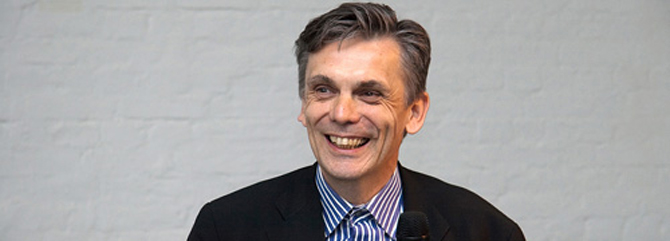
“...I think this weekend was really, most of all, the first introduction of the participants to each other. Many of the people met for the first time; certainly most people saw for the first time what the other participants are doing in their schools... it was the first beginning of a discussion which was very fruitful, very interesting, highly informative... there were first exchanges, first moments of dialogue... there were certainly also joint experiences which I think is very important... for example, today on the Sunday morning, the three key-note lectures which I think as a joint piece of information... will form a point of reference for further discussions... it’s been a productive weekend, very energetic, very good mood... all the participants are gearing up to take part in this network and I think it formed a very good basis for what hopefully will become a fruitful exchange.”
Extract from interview with Matthias Sauerbruch – Chairman of the ANCB BoardGlobal Developments and Academic Networks:
EDUCATING THE GLOBAL ARCHITECT
New Policies of Space in Times of Globalization
Symposium Programme
Saturday, April 18th, 2009
9:30 AM Welcome: Hans-Jürgen Commerell and Kristin Feireiss
Introduction of the Campus concept: Prof. Matthias Sauerbruch
Introduction of the symposium and moderation: Ilka Ruby and Andreas Ruby
Panel 1
10:00 AM Prof. Wolf D. Prix, University of Applied Arts, Austria
10:15 AM Prof. Leon van Schaik, Royal Melbourne Institute of Technology, Australia
10:30 AM Prof. Hannah le Roux, University of the Witwatersrand, South Africa
Panel 2
11:00 AM Prof. Dr. Dr. h.c. Hans-Peter Schwarz, Zurich University of the Arts, Switzerland
11:15 AM Prof. Ute Meta Bauer, Massachusetts Institute of Technology, USA
11:30 AM Prof. Haewon Shin, Korea National University of Arts, Korea
Panel 3
1:00 PM Prof. Hitoshi Abe, University of California Los Angeles, Japan/USA
1:15 PM Prof. Philip Parker, Pratt Institute, USA
1:30 PM Prof. Iñaki Echeverría, Universidad Iberoamericana/Universidad Anáhuac, Mexico
1:45 PM Marianne Müller & Olaf Kneer, Architectural Association School of Architecture, Great Britain
Panel 4
2:15 PM Prof. Alfredo Brillembourg & Prof. Hubert Klumpner, Columbia University, New York, USA
2:30 PM Prof. Mathias Klotz, Universidad Diego Portales, Chile
2:45 PM Ulf Hackauf, The Why Factory (T?F), Technical University Delft, Netherlands
Panel 5
3:45 PM Prof. Leonid Lavrov, St. Petersburg State University of Architecture, Russia
4:00 PM Prof. Robert Mull, London Metropolitan University, Great Britain
4:15 PM Prof. José L. E. Penelas & Prof. Anel L. Fernandez, Universidad Europea de Madrid, Spain
4:30 PM Prof. Odile Decq, École Spéciale d‘ Architecture, France
Sunday, April 19th, 2009
Roundtable-Matineé‚ OPERATING IN THE GLOBAL FIELD (click here to read more)
12:00 AM
Keynote speakers:
Dr. Edward Schwarz, Director, Holcim Foundation for Sustainable Construction, Switzerland
Dr. Robert Annibale, Director of Microfinance, Citigroup, New York, USA
Peter Claussen, BMW Group, Leipzig, Germany
Moderation: Ilka Ruby and Andreas Ruby
SYMPOSIUM THEME: “EDUCATING THE GLOBAL ARCHITECT”
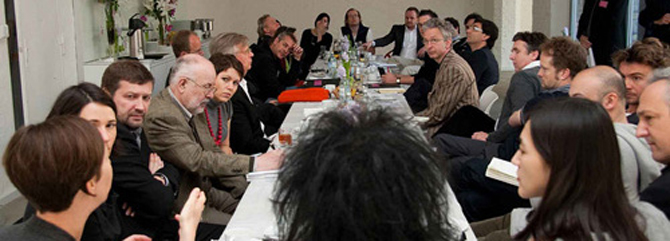
The architecture discipline is affected by globalisation not only in terms of its practice, but also in terms of its social and cultural roots. While global operation has become commonplace for architects, their traditional points of reference have steadily deteriorated. If globalisation is about the dissolution of borders, space making is its opposite – the definition of limits. In this way, architecture is both agent and victim in the redefinition of global borders. As a physical manifestation of the archetypal desire to establish identitiy through distinction, the making of space becomes a socio-economical, cultural and political act for which our future city makers need to be prepared. The five panels were asked to address the following questions.
1. Which new spaces are emerging within current geopolitics?
2. How do these forces change your practice and how do they affect your notion of urban life?
3. What are appropriate ways to react to these challenges, and what may be appropriate methods of investigation within educational frameworks?
SYMPOSIUM INTRODUCTION
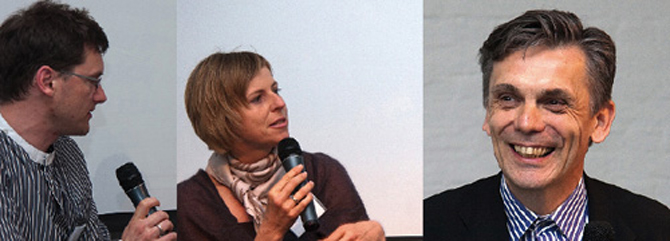
Matthias Sauerbruch described the profession to be challenged as architects have not yet found their points of reference within a globalised market. Until recently architects understood themselves to follow a moral mission in the belief that architecture would help to resolve social, political and cultural problems as well as provide physical structures. Now, architects are required to operate in unfamiliar circumstances which are, at best, only superficially understood. Within this global situation, Sauerbruch questioned the profession’s two most obvious patterns of behaviour: either the full embrace of the superficial and generic or the retreat to the radically subjective in a desperate search for authenticity. A third way, he suggested, may be able to transcend this nauseating deadlock . Engaging in varied collaborations, and building networks between individuals and institutions of different national and professional backgrounds a situation may emerge that starts to be able to cope with the complex issues of contemporary practice and may help the profession to overcome its current stasis.
Ilka and Andreas Ruby’s introduction to the discussion panels further examined the themes of networks and exchange introduced by Sauerbruch, stating that ANCB can become a veritable network hub which enables trans-cultural contact and exchange. Consequently, it is the ambition of ANCB to train students to be able to address highly diverse issues and operate within many different cultural, economical and political conditions in order to address the ever-changing parameters of the profession. ANCB is envisioned to become a new platform for education in which trans-cultural exchange and collaboration becomes second nature.
The subsequent panel discussions were intended as an initial forum in order to begin formulating the ways in which various institutions expect ANCB to operate and what the advantages of collaboration could be.
PANEL 1
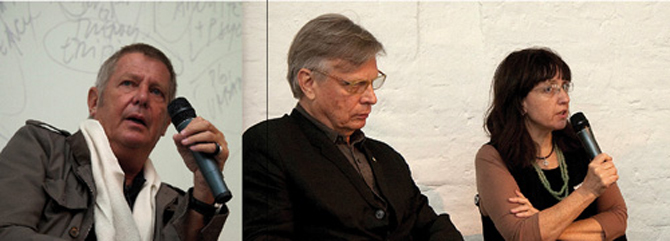
Prof. Wolf D. Prix, University of Applied Arts, Austria
Prof. Leon van Schaik, Royal Melbourne Institute of Technology, Australia
Prof. Hannah le Roux, University of the Witwatersrand, South Africa
Wolf Prix began his presentation by criticising Matthias Sauerbruch’s bipolar opposition between the generic and the subjective by suggesting architecture is the three dimensional manifestation of society. He thus highlighted central concerns of the discussion: How can one – as a globally acting architect – interpret what the context of a potentially foreign context is; and how can that interpretation can be manifested as a believable and meaningful intervention?
In his presentation, Leon van Schaik stressed the importance of research, not necessarily the actual physical manifestation, but rather what he described as the medium of architecture. His model – integrated scholarship – aims at negating the split between practice and research. Consequently, from an academic perspective, the notion of knowledge dissemination is an important means with which to affect and potentially be affected by the professional realm. In deliberate contrast to the approach of probing the underlying structuring principles of architecture, he also introduced the importance of personal histories in the creative process by teaching students to become self-curators. Thus, there are clear connections to the bipolar model initially presented, but – like Sauerbruch – there is a clear desire to reject and transcend any form of dichotomic relationships.
In Hannah le Roux’s presentation, a strong sense of social responsibility and concern emerged. In light of South Africa hosting the football world championships in 2010, football was used both as a metaphor and actual physical manifestation of the profession as a whole as well as for the dilemmas facing individual students in South Africa. She contrasted, for example, FIFA’s highly regimented protocols as a means of colonisation and potential seclusion with the ad hoc impromptu organised games of local children. This does not only present a dilemma to the profession, but also highlights the students’ difficulty in finding an ethical and responsible way of dealing with their immediate context. As a potential way out of this moral dilemma she presented a dialectical model consisting of the extreme poles ‘resist’ and ‘plan’ with the notion of ‘agency’ as a productive third way. Thus, ANCB could, to a certain extent, be characterised as an unplanned game of football – a space with certain protocols that have enough ‘slack’ built-in to allow for improvisation and the bending of those rules. In addition, ANCB is not an empty shell waiting to be filled with new content, but rather a place with an accumulated history and knowledge that can be tapped into.
From the first discussion, it is evident that there are widely different ideological positions. Prix, for example, places the importance on form whereas van Schaik emphasizes the underlying parameters that in turn may generate a physical presence. Furthermore, there are also pronounced differences in terms of physical location. Le Roux operates literally from the periphery of the world, her institution looking towards a perceived distant centre, whereas Prix represents the fully globalised idiom that has transcended even the centre. As such, these frictions should be considered to be the very fuel for a successful inquisitive climate as a consensus situation would only lead to a non-critical inoperative stasis. Everyone, however, was in full agreement that ANCB ultimately should be a network enabling productive and critical exchange between the participating institutions.
PANEL 2
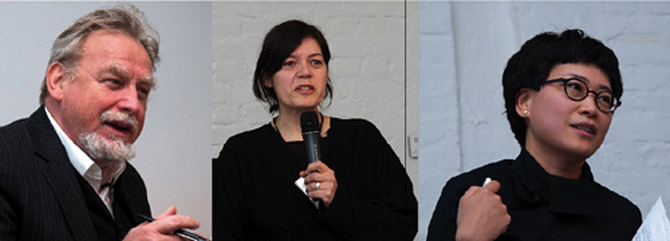
Prof. Dr. Dr. h.c. Hans-Peter Schwarz, Zurich University of the Arts, Switzerland
Prof. Ute Meta Bauer, Massachusetts Institute of Technology, USA
Prof. Haewon Shin, Korea National University of Arts, Korea
The second discussion panel commenced with Hans-Peter Schwarz’s presentation. Within a global context he introduced the notion of trans-disciplinarity as a mode of operating that transcends past eras when architects thought they could solve social, political and economical situations with more architecture. At Zurich University of the Arts students are specifically trained to understand the languages and complexities of other professions; sometimes by literally displacing a student into a foreign context. The students’ real-life collaborations are instrumental to their education. Consequently, ANCB could be the very place where students become displaced in order to be confronted with the other as well as having the opportunity to participate in a collaborative network.
In her presentation, Ute Meta Bauer described MIT as a hot-house of many different approaches. Its inherently interdisciplinary approach is thus already acting as a model for ANCB. Consequently, the opportunity that ANCB presents is a place away from the hectic environment at MIT – a campus offering focus and time for critical reflection. In that sense she ties in with Schwarz’s notion of displacement as a positive educational act. What is more, Bauer understands architecture not necessarily as only making buildings, but rather as a methodology to address urban and social complexities.
At Korea National University of Arts – founded only twelve years ago – all tutors are practising architects. Haewon Shin stated that this is a conscious policy in order to avoid becoming an institutionalised academic environment. In other words, there is a tendency towards a productive intention to avoid the dichotomic relationship between theory and practice. Furthermore, the exposure of the architectural profession to the open market in 1996 has made the topic of exchange and global collaboration paramount.
If the first discussion panel agreed on ANCB as a network for exchange, the second was more specific in emphasising the notion of a place within that network. In other words, ANCB was beginning to be conceived as a specific place enabling exchange. Within this context, Ilka Ruby asked whether ANCB should be a completely global and placeless institution, or if it indeed should be felt that the campus is located in Berlin. Schwarz argued that it matters where one makes an experience and that in a global condition there is an intrinsic need to connect. Although coming from slightly different perspectives, both Bauer and Shin corroborated this view. According to Shin, ANCB has the advantage of offering both a network as well as a specific location for real hands-on experience whereas Bauer sees an opportunity – away from the hot-house – to develop real social networks and enabling students to develop a deeper understanding by having a real base in a foreign city.
PANEL 3
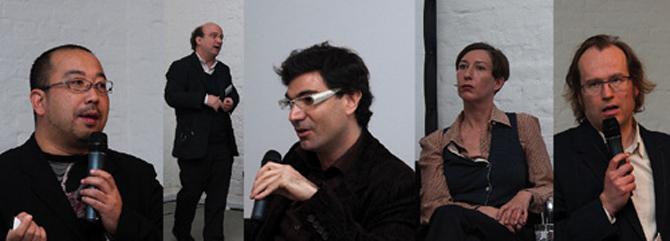
Prof. Hitoshi Abe, University of California Los Angeles, Japan, USA
Prof. Philip Parker, Pratt Institute, USA
Prof. Iñaki Echeverría, Universidad Iberoamericana/Universidad Anáhuac, Mexico
Marianne Müller & Olaf Kneer, Architectural Association School of Architecture, Great Britain
Hitoshi Abe started out by critically reflecting upon his bi-cultural education as an architect in Japan and the US. Whereas the former focused rather on the general education of professionals, who will eventually work in architecture related fields such as development, construction and engineering, the latter offered a more distinct definition of the profession and clearly emphasized the education of architects with a strong self-conception. Both approaches offer advantages. At UCLA, Abe tries to unify them in the promotion of a critical architectonic practice, combining design, technology and culture by working (1) inter-culturally (i.e. Atelier Bow-Wow in Tokyo), 2) interdisciplinary (i.e. collaborating with experts from diverse hi-tech fields 3) with various institutions and organisations outside of academia (eg. Supra Studio with Toyota, Make-It-Right with Thom Mayne). Essentially critical studies remain the engine for a critical practice at UCLA that steers the architect’s commitment.
Philip Parker of New York’s Pratt Institute addressed the issue of the global by repeatedly highlighting the dialectic notion of the contemporary architect as “nomadic” being. On the one hand constantly moving and ever-accelerating between here and there; on the other hand persistently working across multiple (hyper)media. In an eclectic array of associative images drawing from various fields of knowledge and artistic practices, Parker further promoted his transitory concept of connectivity, playfully moving across these novel information landscapes. As a third notion of the nomadic he referenced intra-faculty migration and exchange of experience at Pratt - which he compared to the intersecting of nomadic tribes.
After referring to his education and studies in Mexico, the US and abroad, Inaki Echeverría expressed his personal disbelief in the concept of the much discussed “global” which he believes has already exhausted itself, yet stressed his interest in the very concept of “demarcation”. For Echeverría, globalization is not so much a continuation of the world wide process of internationalization but of demarcation practices of “worldification” which he also regards as the focal point of research for future work at ANCB. Echeverría further argued for a younger generation of architects, for whom information per se is not the pivotal question in the accumulation of knowledge, but rather the interactive procedure of exchange - which in return not only fosters the emergence of new practices in architecture but also grant a right to the possibility of uncertainty.
Müller Kneer teamed up for an impromptu lecture on the unconventional and subversive educational concept of the AA, by setting up a number of conspiracy theories for the dis(re)organisation of the architect. Against the backdrop of outdated concepts for the modern architecture school, the AA seeks to set up models of (mis)behaviour by offering self-organized and initiated education environments that encourage D.I.Y. experimentation as well as extended means of communication and information sharing across various media and backgrounds. Generally speaking the school conceives itself as a highly diversified and hybrid hub in which knowledge exists as a dynamic and somewhat fluid aggregate rather than as a static condition.
PANEL 4
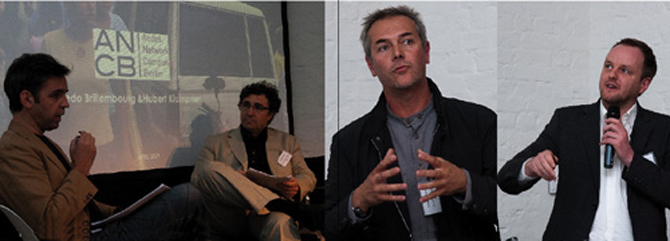
Prof. Alfredo Brillembourg & Hubert Klumpner, Columbia University New York, USA
Prof. Mathias Klotz, Universidad Diego Portales, Chile
Ulf Hackauf, The Why Factory (T?F), Technical University Delft, Netherlands
Alfredo Brillembourg and Hubert Klumpner presented the work and mission of their interdisciplinary research lab at the Columbia University, SLUM LAB (Sustainable Living Urban Model) in which they try to develop a series of tactics and means of engagement for the upgrading of slums and other less developed informal settlements. Thereby they circumscribed their field of operation by tracing an invisible trajectory across a political equator running along a south to north axis. This global demarcation line seperates areas of excess and those of need. Confirming the inevitability of social and economic redistribution on a global scale in the future against the backdrop of the undeniable failure of the current status quo, Brillembourg and Klumpner called upon the power of design and architecture as a transformational tool.
Chilean architect Matthias Klotz tackled the question of architectural education and globalization by stressing the importance of understanding specific local contexts and conditions. He did so by discussing Chile’s geographical isolation from other latin-american countries as well as the division of his homecountries educational system in public and private schools and income perspectives for architects. Ultimately he argued for a more familiar and local-bound line of action for architects (no further then one-night-flights) and against the turbulence of today’s jetset lives.
The third panelist, Ulf Hackauf, introduced the world wide wonder works of Winy Maas’ The Why Factory (T?F) at the TU Delft which concentrates on the production of models and visualizations for future cities. Giving examples of projects realized by MVRDV in the past as well as new and upcoming projects by T?F, Hackauf provided numerous powerful images for the possible directions of our urban futures. With its focus on the experimental development of utopian visions of the city of tomorrow T?F’s Future City Program is undertaken through the interactive composition of three fields. It speculates on possible theoretical models in the model city program. It makes counter proposals for existing cities and it tries to store its knowledge through an evolutionary gaming program.
PANEL 5
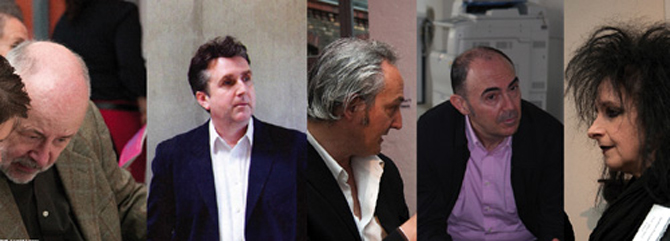
Prof. Leonid Lavrov, St. Petersburg State University of Architecture, Russia
Prof. Robert Mull, London Metropolitan University, Great Britain
Prof. José L. E. Penelas & Angel Luis Fernández, Universidad Europea de Madrid, Spain
Prof. Odile Decq, Executive Director, École Spéciale d’ Architecture, Paris, France
Leonid Lavrov, tackled the question of participation in city planning processes and the dichotomy of city politics and economy. He provided insight into St Petersburg’s interesting and heterogeneous history, explaining the importance of historical knowledge for the architect. Lavrov argued for an intensification of international contact between architects. He also argued that today’s problem is not lack of information but rather information overflow: information we are not yet able to understand. Lastly, Lavrov advocated ethics for the architect, acknowledging that the relationship between client and architect has changed.
Robert Mull explained that diversity is the architect’s greatest resource but also the most difficult obstacle. The MU operates in a diverse community of research, practice and education. It is neither interested in an elitist arch-conversation nor in architectural production promoted by the press. The central idea is rather duty of care. Mull argued for an ethics of architecture that considers its own implications. Designers must constantly switch between the roles of citizen and professional. In this way, participatory design not only asks questions but also leads to action. The main task, Mull explained, is to influence political, social and economic infrastructures. Architects must be agents of change. Furthermore, the design process cannot operate without materiality and prototyping: it is fundamental to be good at building the real thing at every scale.
In response to the notion of the “Global Architect” Odile Decq argued that to be global does not only mean to travel and that architects must also take care of the local. She reflected that globalisation is operating through the exchange of goods and money in a time when many people are unable to cross borders. It is therefore important for architects to consider the problems of migration. This leads Decq to the belief that ANCB’s future visions should not necessarily concentrate on technology but rather on the question of how we should live together. Decq described her school’s structure as operating by semester rather than by year, creating a faster pace and rhythm. Every six months the school has an exhibition and publishes a magazine. The school is divided in two post-graduate programs: Architecture des Milieus, driven by a philosopher and Urban Mutations. New fields of research include: the Banlieus of Paris, Kenya with NGO, Mongolia, and an exchange with Istanbul and Ankara.
José L. E. Penelas & Angel Luis Fernández began by speaking briefly of the university’s structure, whose 700 architecture students and 250 visual arts students work closely with researchers to develop work which is equally focussed on the local as it is on the global. Penelas went on to advocate a very personal, humanist approach to architecture and indeed architectural education, stating that it was time for the emergence of a new meta-architecture generated from the human interior: an architecture drawn from the emotions, experiences and perceptions of its creators. To this end, he believes we need to be looking to the sciences, literature and music in order for the field of architecture to undergo a transformation which will open it to new interpretations and meanings.
Summary by Michael Roper - Programme ManagerROUNDTABLE MATINEÉ: OPERATING IN THE GLOBAL FIELD
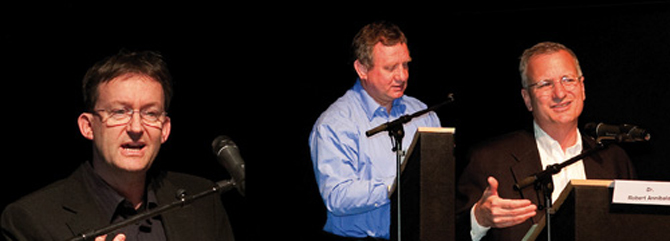
Dr. Edward Schwarz, Director, Holcim Foundation for Sustainable Construction, Switzerland
Dr. Robert Annibale, Director of Microfinance, Citigroup, New York, USA
Mr. Peter Claussen, BMW Group, Leipzig, Germany
Moderation: Ilka Ruby and Andreas Ruby
On the third and final day of the inaugural symposium, thanks to the initiative of Matthias Sauerbruch, we were lucky enough to hear from three great orators from outside the architecture profession. Representing the diverse fields of sustainable construction, micro-finance and automotive engineering, the three speakers expanded on themes developed in the panel discussions thereby exposing ANCB to a broader debate with concern to notions of global operation.
Edward Schwarz began with a presentation on the initiatives of the Holcim Foundation, promoting environmentally sustainable construction within an industry that is responsible for a significant proportion of global resource consumption.
This was followed by Peter Claussen of the BMW Group, whose presentation focussed on organisation systems and modes of discourse as tools for directing strategic development, both micro and macro.
Finally, Robert Annibale spoke about the micro-finance arm of Citigroup, focussing on their work as symbiotic agents of economical development and their methods of adapting to the self-organisational behaviours of communities living in third-world slum settlements.
All three presentations provided a welcome shift from the more architecturally focussed panel discussions, concluding the symposium with a lively discussion and debate into the broader issues of global urbanism and sustainability. Moderated by Ilka and Andreas Ruby, the roundtable matineé was a key component in the ANCB agenda, fostering a truly trans-disciplinary dialogue in order to more effectively address issues concerning the sustainable development of our future urban environments. This is a discussion which will continue on the ANCB campus, with ongoing input from a broad range of fields and expertise.
The symposium was friendly supported by:


